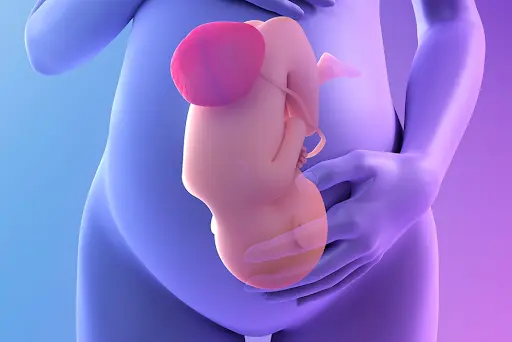
[adinserter block=”3″]
Anterior Placenta is when the Placenta grows in front of the uterine wall, which is very common. Some women with this may not feel their baby’s kicks as much, and that’s okay. The thicker part of the placenta in the abdomen can make it a bit harder to notice those early movements, like “flutters.” But as your baby grows, you should still feel movements in the third trimester. If you ever see fewer kicks, it’s a good idea to tell your doctor. They can check things out and make sure everything’s going well.
What is Anterior Placenta?
An anterior placenta means the Placenta is attached to the uterus’s front wall, closest to the mother’s belly, instead of more towards the back. Having the Placenta at the front of the uterus can sometimes create challenges, but it is still normal. In addition, no effects of the anterior placenta can be felt during pregnancy.
The placenta’s formation occurs during the implantation of a fertilized egg in the uterine wall. It helps take the nutrients, hormones, and oxygen to the baby. Some studies suggest that anterior placenta is frequent in women with the O-positive blood group. Placental positioning may be a significant predictor of pregnancy outcomes.
Why do some women have an Anterior Placenta?
Anterior placentation happens in around 1 in 4 pregnancies. While experts aren’t entirely sure why some women develop an anterior placenta vs a posterior one, here are some of the factors that are thought to play a role:
- Uterine shape and capacity: If the uterus tilts backward slightly (anteversion or retroversion), it influences where the placenta embeds itself. The anterior-tilted uterus is associated with a higher likelihood of the placenta forming on the front wall.
- Prior pregnancies: One theory suggests that trace scar tissue remaining in the uterus lining from a previous pregnancy, surgery like a C-section, or infection/damage can cause preferential placental attachment. This could make the anterior location more probable for second-time moms.
- Timing of embryo implantation: There may be something about very early embryonic burrowing and adherence to the nutrient-rich endometrium lining that determines if the cells settle more toward the front or back of the uterus. But this remains speculation currently.
- Random chance: Some shapes of the uterus and scattered uterine tissues can make it more likely to have an anterior placenta, but there’s also an element of luck involved. The development of the baby and how it attaches inside involves very complex signals between cells and specific conditions that lead to the creation of the placenta and amniotic sac in a particular place. It’s like a tiny miracle happening inside the belly.
What are the symptoms of Anterior Placenta?
You must know that having an anterior placenta won’t cause many symptoms. Although there won’t be any pregnancy and delivery problems, you should still be aware of the common signs.
Some of the most common symptoms of Anterior Placenta may include:
- Baby’s Movement: Getting a baby’s kick or punch may take many months. It will take 18 months for the posterior placenta to feel kicked and 20 months in the case of the anterior placenta. Your baby may be weaker or softer due to the placenta’s barrier between the belly and the baby.
- Heart Rate of the Baby: The doctors claim that heart rate gets detected a little later with Doppler Ultrasound Furthermore, the time taken can be longer as the placenta is struck between the baby and Doppler
How can you diagnose the anterior placenta?
Your healthcare expert may diagnose the anterior placenta with an ultrasound. It is done around 18 to 21 weeks of pregnancy. In addition, the diagnostic test can be referred to as an anatomy scan. Further, the baby’s size and all its organs are measured precisely.
The placenta often tends to change positions with the expansion of the uterus. Accordingly, the anterior placenta stays undiagnosed for 20 weeks.
Does the Anterior Placenta Affect Pregnancy?
Having an anterior placenta can affect the pregnancy experience. While it’s generally not considered harmful, it might make it a bit more challenging for the mother to feel the baby’s movements, especially in the early stages. The placenta’s position at the front can act as a cushion, making the kicks and movements less noticeable. However, as the pregnancy progresses, the baby’s growth usually makes the movements more perceptible. It’s essential to keep the healthcare provider informed about any concerns or if there’s a significant reduction in fetal movements.
What are the risks of anterior placenta?
Fortunately, anterior placenta complications won’t disturb you or your little one. It’s not at all dangerous for your delivery. Yet, we must check with the healthcare expert for anything as such.
There are a few potential complications with the anterior placenta, including:
- C-section: If you have an anterior placenta, you are most likely to have Cesarean delivery. Here, the placenta blocks the baby from getting out through the vagina.
- Placenta Previa: When the Placenta covers all the parts of the cervix, mild to heavy bleeding can occur. Many other additional complications were seen after placenta previa.
- Back Labor: Your baby can be in an occiput posterior position if having an anterior placenta. It shows that the baby’s head is down, but the face is up. You may have more prolonged labor and more back pain.
How is the baby’s movement in the anterior Placenta?
One of the risks of anterior placenta mainly involves a reduced sensation of baby kicks. A to-be-mom can have worrisome reactions if the baby inside isn’t kicking or punching. The baby’s movement in the anterior placenta can be more complex to feel. Your Placenta may come between the belly and baby until 20 weeks of pregnancy.
The baby may kick, but before 20 weeks, it won’t be strong enough to feel that. Find the right doctor and discuss your feelings with him.
Can you consider the anterior placenta suitable for expected delivery?
The final answer to this question is a big yes; having an anterior placenta can result in standard delivery. There will be no impact on your delivery with the anterior placenta. However, you may also go through a C-section with the anterior placenta. However, if one has placenta previa, the delivery may be affected.
Conclusion
Many women go through the anterior placenta, and everyone tries to find a solution to get out of it. However, it may not help if you try finding any treatment options. You may wonder if the baby is in a good state or not. Therefore, it is essential to contact a gynecologist for the same.
Relax. You’re not the only one. There are no underlying side effects for the same. However, if you have extreme back labor, speak to your doctor. For this, you may also visit Credihealth.
Frequently Asked Questions
What should I expect after having an anterior placenta?
You may not feel your baby’s movements after having an anterior placenta.
Can the anterior Placenta get fixed by itself?
The anterior Placenta may be fixed by moving locations upon the pregnancy’s progress.
Is the anterior Placenta complicated?
Anterior Placenta is more complicated than it seems.
Does an anterior placenta have any correlation with the baby’s gender?
There is no known link between the location of the Placenta (anterior vs posterior) and the baby’s gender.
Can C-section be safe for the anterior Placenta?
C-section can be more complicated if you have an anterior placenta.
What are the risks with the anterior Placenta?
Anterior Placenta can be associated with an increased risk of hypertension, placental abruption, and intrauterine fetal death.
[adinserter block=”3″]
Credit : Source Post






